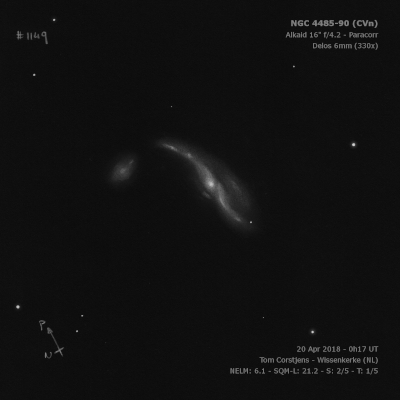
William Herschel discovered NGC 4490 = H I-198 = h1308, along with NGC 4485, on 14 Jan 1788 (sweep 798) and recorded "Two, the most south [NGC 4490] vB, vL, iE. That to the north B, pS, iF, about 1 1/2' distance." JH logged "vB; vL; mE; 40° np to sf; easily resolvable."
An accurate sketch was made of NGC 4485 and 4490 at Birr Castle on 27 Mar 1856 (figure 23, Plate XXVII in the 1861 publication). It showed the northwest tip curling towards NGC 4485 and a faint streak, corresponding to a string of HII regions, along the north edge of the galaxy.
300/350mm - 13.1" (2/16/85): very bright, large, striking, elongated 2:1 NW-SE, 6'x3', large bright core is elongated and grainy. A very faint arm extends from the NW end in the direction of NGC 4485 3.6' NNW. A small extension (arm) at the SE end is suspected. Similar view and sketch made on 2/23/85. On 4/12/86, just a hint of curvature was noted towards NGC 4485.
400/500mm - 18" (6/7/08): I viewed this interesting pair in my 15x50 IS binoculars (just a faint blur), 18" Starmaster (disturbed arm on the WNW end extending towards NGC 4490 easily visible) and the 33.4" f/5 (internal structure visible).
18" (6/13/07): very bright, large, elongated 5:2 WNW-ESE, ~5'x2', with a very bright oval core, ~45"x30". The surface brightness is irregular or mottled but most interesting is a small extension or arm that juts out of the WNW end and appears to bend or hook north towards the companion NGC 4485. There appears to be a smaller counterpart at the ESE end that slightly protrudes from the main body. With averted vision, the galaxy grows wider and appears ~5'x2.5'. Located 39' NW of mag 4.3 Beta CVn. Member of the CVn II Group (brightest member M106).
18" (6/4/05): very bright, large, elongated 2:1 NW-SE, contains a large, bright core. At the northwest end a faint arm appears to emerge hooking sharply to the north for 1' towards NGC 4485. At the southeast end, there appears to be slight extension without much curvature near a 16th magnitude star. The central region is weakly concentrated to the center. Overall, the galaxy has a mottled, slightly splotchy appearance as if was dusty or knotty with HII regions. Located 40' NW of 4.2-magnitude Beta Canum Venaticorum.
600/800mm - 24" (5/27/17): very bright, large, elongated ~5:2 WNW-ESE, ~5'x2.2', fairly high but irregular surface brightness, brighter core, but seems offset from center. A long arm (somewhat detached from the brighter central region), sweeps WNW and curls north near the end (bending towards companion NGC 4485). Fascinating unusual structure.
900/1200mm - 48" (5/1/19): at 375x; several HII knots were identified along the north side of this remarkable galaxy. NGC 4490:[VS65] 19, 22 and 23 are three very close, tiny knots oriented WNW-ESE [total length 22"] along the north edge of the central region. The middle knot (#22) was the brightest but only ~6" and the last knot (#23) was the faintest. NGC 4490:[VS65] 02 was a fairly bright, elongated glow on the NW edge of the galaxy [1.8' from center]. On close inspection it resolved into two extremely small knots. These designations are from 1965 study of HII regions in NGC 2403, 2903 and 4485/4490 by Véron and Sauvayre.
Notes by Steve Gottlieb